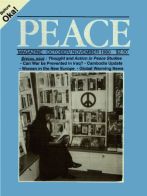
Peace Magazine Oct-Nov 1990, page 12. Some rights reserved.
Search for other articles by peacemag here
THIS EDITION WAS edited by a small cooperative—three peace educators associated with MeMaster University’s Centre for Peace Studies—Paul Dekar, Graeme MacQueen and Joanna Santa Barbara. Our chosen focus is one which has been provocative for us—the relationship between thought and action in peace studies. Nurturing this linkage has led to some of what we are most proud of in our own work-and also to criticism. The criticism can be simply stated: Taking action means committing yourself to a position and this disqualifies you from objectively and dispassionately considering all sides of an issue.
The linkage between thought and action is examined in a variety of ways by the writers in this edition, together with other challenging issues. Lead writer Anatol Rapoport argues that the fundamental aim of peace workers, “the fundamental aim of peace workers,” the eradication of war as an institution,” requires “pervasive enlightenment about the nature of the global war system… Production of this knowledge should be the aim of peace research, its dissemination the aim of peace education, its utilization in pursuit of the common goal the task of peace activism.
Land writer Donna Smyth looks at the profound changes in our own thinking demanded by the four great movements of our time-peace, environment, social justice, and feminism. One task ofpeace education is to help us stop thinking inpolar opposites.
Two of the educators featured in this issue ply their trade in the midst of wars. José Luis Argueta Antillon is Rector of the Universitv of El Salvador, which has been a particular target of government forces in the civil war in that country. He sees that extraordinary circumstance as having stimulated creative processes of reform in his university and as strengthening the linkage between thought and action in all areas of learning.
Julio Quan, Director of the Program in Cohflict Resolution at the University for Peace, Costa Rica, teaches nonviolent strategies in violent situations, promotes nonviolent alternative security, and is activating peace education in Central America.
Former students of peace studies programs in Canada speak with verve and enthusiasm of how their thoughts have translated into action. Finally, to return to the criticism of linking thought and action, a hard task is set for the walker for Nitassinan or the painter of sidewalk shadows for Hiroshima Day—the task of understanding those who want low level flight testing, who manufacture armaments, who can plan nuclear scenarios in which millions will die. This understanding is part of the peace process and one of the tasks of peace education.

Peace Magazine Oct-Nov 1990, page 12. Some rights reserved.
Search for other articles by peacemag here